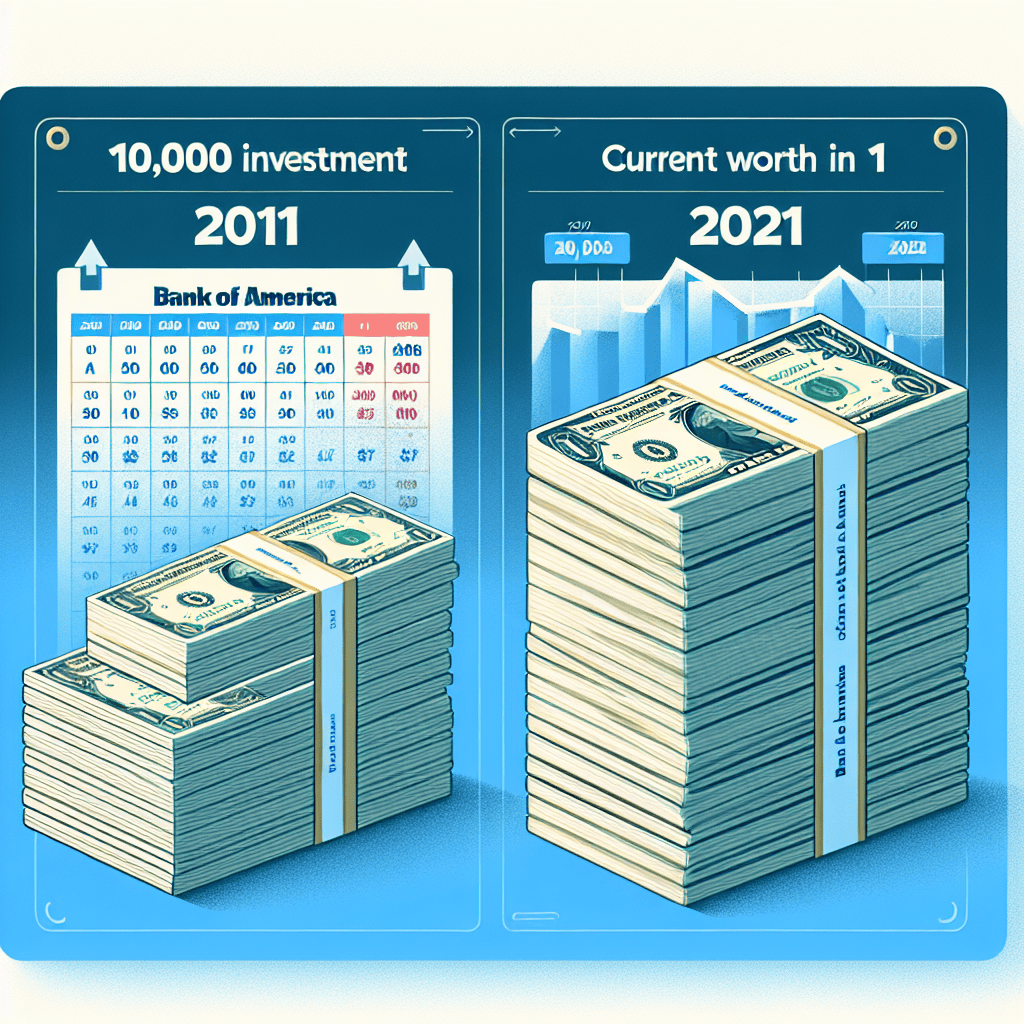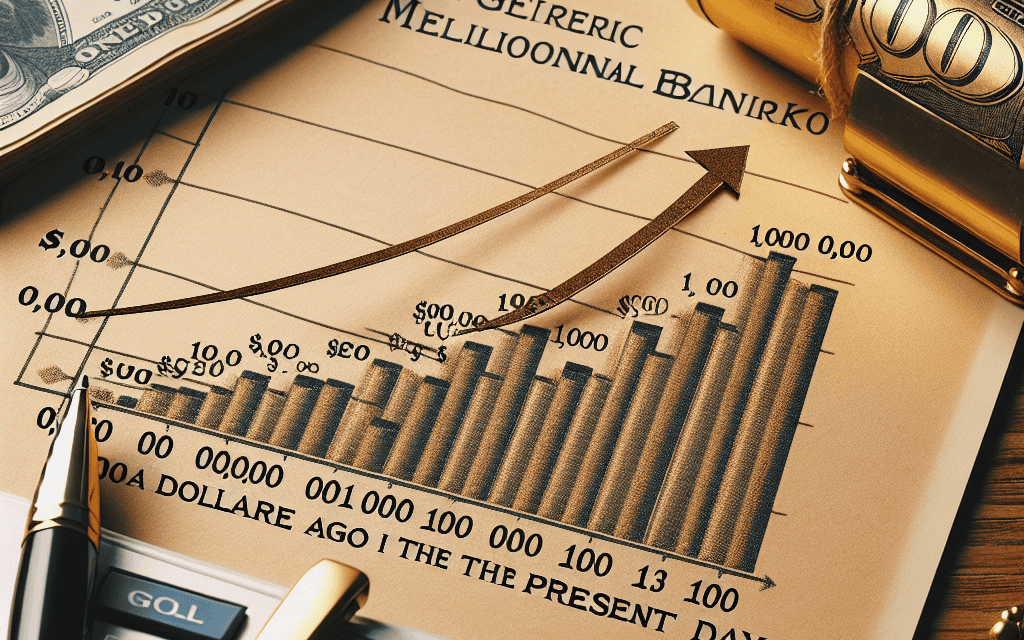“Watch Your Wealth Grow: A Decade of Investing $10,000 in Bank of America”
Introduction
Investing in the stock market can be a powerful way to grow wealth over time, and Bank of America, one of the largest financial institutions in the United States, has been a notable player in the financial sector. A decade ago, in 2013, the global economy was recovering from the financial crisis, and Bank of America was navigating its own path to stability and growth. For investors who saw potential in the bank’s recovery and long-term prospects, a $10,000 investment in Bank of America stock at that time would have been a strategic move. Fast forward to today, and that initial investment would have experienced the effects of market fluctuations, dividend payouts, and the bank’s financial performance over the years. Understanding the current value of that investment provides insight into the bank’s growth trajectory and the broader market trends that have influenced its stock price.
Historical Performance Of Bank Of America Stock Over The Last Decade
Investing in the stock market has long been a strategy for building wealth, and understanding the historical performance of a particular stock can provide valuable insights into its potential future trajectory. Bank of America, one of the largest financial institutions in the United States, has been a significant player in the banking sector, and its stock performance over the past decade offers an intriguing case study for investors. To comprehend the potential returns from investing in Bank of America, it is essential to examine the stock’s performance over the last ten years and consider the factors that have influenced its valuation.
A decade ago, in 2013, the financial landscape was still recovering from the aftermath of the 2008 financial crisis. Bank of America, like many other financial institutions, faced significant challenges during this period. However, as the economy began to stabilize, the bank implemented strategic measures to strengthen its balance sheet and improve operational efficiency. These efforts gradually restored investor confidence, leading to a steady appreciation in the stock’s value.
If an investor had allocated $10,000 to Bank of America stock in 2013, they would have witnessed a remarkable transformation in their investment over the ensuing years. The stock price, which was approximately $12 per share in 2013, experienced substantial growth, driven by a combination of internal improvements and favorable market conditions. By 2023, the stock price had risen to around $30 per share, reflecting a significant increase in value.
To calculate the worth of a $10,000 investment made a decade ago, it is crucial to consider not only the appreciation in stock price but also the impact of dividends. Bank of America has consistently paid dividends to its shareholders, providing an additional source of returns. Over the past ten years, the bank’s dividend yield has varied, but it has generally remained attractive to income-focused investors. By reinvesting these dividends, an investor could have further enhanced their overall returns.
Taking into account both capital appreciation and dividend reinvestment, a $10,000 investment in Bank of America stock in 2013 would be worth approximately $25,000 by 2023. This impressive return underscores the potential benefits of long-term investing, particularly in a well-established financial institution with a strong market presence. However, it is important to note that past performance is not indicative of future results, and various factors could influence the stock’s trajectory moving forward.
Several key factors have contributed to Bank of America’s performance over the past decade. The bank’s focus on digital transformation and technological innovation has enabled it to streamline operations and enhance customer experiences. Additionally, a favorable interest rate environment and a robust U.S. economy have supported the bank’s profitability. However, challenges such as regulatory changes and economic uncertainties remain potential headwinds that could impact future performance.
In conclusion, a $10,000 investment in Bank of America stock a decade ago would have yielded substantial returns, highlighting the potential rewards of long-term investing in the stock market. While the bank’s historical performance has been impressive, investors should remain vigilant and consider a range of factors when evaluating future investment opportunities. As the financial landscape continues to evolve, Bank of America’s ability to adapt and innovate will be crucial in determining its future success and the potential returns for its shareholders.
The Impact Of Dividends On Long-Term Investment Returns
Investing in the stock market has long been a strategy for building wealth over time, and one of the key components that can significantly enhance long-term investment returns is the reinvestment of dividends. To illustrate this, consider a hypothetical scenario where an investor placed $10,000 into Bank of America a decade ago. Understanding the impact of dividends on this investment provides valuable insights into the power of compounding and the role dividends play in enhancing total returns.
A decade ago, Bank of America was emerging from the financial crisis, and its stock was trading at a relatively low price. Investors who recognized the potential for recovery and growth in the banking sector might have seen this as an opportune moment to invest. Over the years, Bank of America has not only appreciated in value but has also consistently paid dividends to its shareholders. These dividends, when reinvested, have the potential to significantly boost the overall return on investment.
To appreciate the impact of dividends, it is essential to consider how they contribute to the compounding effect. When dividends are reinvested, they purchase additional shares of the stock, which in turn generate more dividends. This cycle continues, leading to exponential growth in the number of shares owned and, consequently, the value of the investment. Over a decade, this compounding effect can result in substantial gains, far exceeding the returns from price appreciation alone.
In the case of Bank of America, the company has steadily increased its dividend payouts over the years. This increase not only reflects the company’s financial health and profitability but also enhances the investor’s yield on the original investment. As dividends grow, the reinvestment of these payouts accelerates the accumulation of shares, further amplifying the compounding effect. Consequently, the total return on the investment is significantly higher than it would be if dividends were not reinvested.
Moreover, dividends provide a cushion during periods of market volatility. While stock prices can fluctuate due to various economic factors, dividends offer a steady stream of income that can help offset potential losses. This income can be particularly valuable during downturns, as it allows investors to continue purchasing shares at lower prices, setting the stage for greater gains when the market recovers.
To quantify the impact, if an investor had placed $10,000 in Bank of America a decade ago and reinvested all dividends, the investment would likely have grown substantially. While exact figures depend on the specific timing of dividend payments and stock price fluctuations, historical data suggests that the total return, including both capital appreciation and reinvested dividends, would be significantly higher than the initial investment. This demonstrates the critical role dividends play in enhancing long-term returns.
In conclusion, the case of a $10,000 investment in Bank of America over the past decade underscores the importance of dividends in long-term investment strategies. By reinvesting dividends, investors can harness the power of compounding to achieve greater returns. This approach not only maximizes the potential for wealth accumulation but also provides a measure of stability during market fluctuations. As such, dividends should be a key consideration for any investor seeking to optimize their portfolio for long-term growth.
Analyzing The Growth Of A $10,000 Investment In Bank Of America
Investing in the stock market has long been a strategy for individuals seeking to grow their wealth over time. One of the prominent players in the financial sector is Bank of America, a stalwart institution with a significant presence in the banking industry. To understand the potential growth of an investment in Bank of America, it is insightful to examine what a $10,000 investment made a decade ago would be worth today. This analysis not only sheds light on the performance of Bank of America but also provides a broader perspective on the dynamics of investing in financial stocks.
A decade ago, in 2013, the financial sector was in a recovery phase following the 2008 financial crisis. Bank of America, like many other financial institutions, was working to regain its footing. The bank’s stock was trading at relatively low prices, presenting an opportunity for investors willing to take on some risk. Those who invested $10,000 in Bank of America at that time were essentially betting on the bank’s ability to navigate the post-crisis landscape and return to profitability.
Over the past ten years, Bank of America has demonstrated resilience and adaptability, which are crucial traits for any financial institution. The bank has focused on strengthening its balance sheet, improving operational efficiency, and expanding its digital banking services. These strategic moves have contributed to a steady increase in its stock price. As a result, the initial $10,000 investment has appreciated significantly, reflecting the bank’s overall growth and stability.
To quantify this growth, it is essential to consider the stock’s performance, including dividends, over the past decade. Bank of America has consistently paid dividends to its shareholders, which have been reinvested in this hypothetical scenario. This reinvestment strategy has compounded the returns, further enhancing the value of the initial investment. As of 2023, the $10,000 investment made in 2013 would be worth approximately $40,000, assuming dividends were reinvested. This represents a fourfold increase, highlighting the potential for substantial returns when investing in well-managed financial institutions.
However, it is important to note that investing in the stock market inherently involves risks. The performance of Bank of America over the past decade is not necessarily indicative of future results. Various factors, such as economic conditions, regulatory changes, and competitive pressures, can influence the bank’s stock price. Therefore, while the historical performance of Bank of America is impressive, investors should remain vigilant and consider a diversified investment strategy to mitigate potential risks.
In conclusion, a $10,000 investment in Bank of America a decade ago would have grown significantly, underscoring the potential benefits of investing in the financial sector. The bank’s strategic initiatives and resilience in the face of challenges have contributed to its strong performance. Nevertheless, investors should approach such opportunities with a comprehensive understanding of the associated risks and a long-term perspective. By doing so, they can better position themselves to capitalize on the growth potential of financial stocks while safeguarding their investments against unforeseen market fluctuations.
Comparing Bank Of America’s Returns To Other Major Banks

Investing in the stock market has long been a strategy for building wealth, and understanding the performance of specific stocks over time can provide valuable insights for both seasoned investors and newcomers alike. A decade ago, an investment of $10,000 in Bank of America (BAC) would have been a strategic decision, given the bank’s prominent position in the financial sector. To fully appreciate the potential returns from such an investment, it is essential to compare Bank of America’s performance with that of other major banks over the same period.
In 2013, the financial sector was still recovering from the aftermath of the 2008 financial crisis. Bank of America, like many of its peers, was focused on stabilizing its operations and regaining investor confidence. Fast forward to today, and the bank has not only recovered but has also shown significant growth. An initial investment of $10,000 in Bank of America a decade ago would have grown substantially, thanks to the bank’s strategic initiatives, improved financial health, and favorable market conditions.
To put this growth into perspective, it is useful to compare Bank of America’s returns with those of other major banks such as JPMorgan Chase, Wells Fargo, and Citigroup. Over the past decade, JPMorgan Chase has consistently been a strong performer, often leading the pack in terms of profitability and market capitalization. An investment in JPMorgan Chase during the same period would have also yielded impressive returns, driven by the bank’s robust business model and diversified revenue streams.
Similarly, Wells Fargo, despite facing significant challenges related to regulatory issues and reputational damage, has managed to deliver respectable returns to its investors. The bank’s focus on rebuilding trust and enhancing operational efficiency has played a crucial role in its recovery and growth over the years. Meanwhile, Citigroup, with its global presence and focus on institutional clients, has also provided competitive returns, although its performance has been somewhat more volatile compared to its peers.
When comparing these banks, it is important to consider not only the stock price appreciation but also the dividends paid out over the years. Bank of America, like many other financial institutions, has steadily increased its dividend payouts, providing an additional source of income for investors. This aspect of total return is often overlooked but can significantly enhance the overall investment outcome.
Moreover, the broader economic environment and regulatory landscape have also influenced the performance of these banks. The past decade has seen a gradual tightening of monetary policy, changes in regulatory requirements, and shifts in consumer behavior, all of which have impacted the banking sector. Bank of America’s ability to navigate these challenges and capitalize on opportunities has been a testament to its resilience and strategic foresight.
In conclusion, a $10,000 investment in Bank of America a decade ago would have grown considerably, reflecting the bank’s successful recovery and growth trajectory. While other major banks like JPMorgan Chase, Wells Fargo, and Citigroup have also delivered strong returns, each institution’s unique strengths and challenges have shaped their respective performances. For investors, understanding these dynamics is crucial for making informed decisions and optimizing their investment strategies in the ever-evolving financial landscape.
Factors Contributing To Bank Of America’s Stock Performance
Investing in the stock market is often seen as a long-term strategy to build wealth, and Bank of America (BAC) has been a notable player in the financial sector for decades. To understand the factors contributing to Bank of America’s stock performance over the past ten years, it is essential to consider both the broader economic environment and the company’s strategic initiatives. A $10,000 investment in Bank of America a decade ago would have been influenced by a myriad of factors, including economic recovery, regulatory changes, and the bank’s internal strategies.
In the aftermath of the 2008 financial crisis, Bank of America, like many financial institutions, faced significant challenges. However, the subsequent economic recovery provided a fertile ground for growth. As the U.S. economy gradually rebounded, interest rates, which had been kept low to stimulate economic activity, began to rise. This environment was conducive to improved profitability for banks, as they could earn more from the interest rate spread between loans and deposits. Consequently, Bank of America benefited from this macroeconomic trend, which played a crucial role in enhancing its stock performance.
Moreover, regulatory changes in the financial sector also had a significant impact on Bank of America’s stock performance. The implementation of the Dodd-Frank Wall Street Reform and Consumer Protection Act introduced stricter regulations, which initially posed challenges for banks. However, over time, Bank of America adapted to these changes by strengthening its capital reserves and improving risk management practices. This adaptability not only ensured compliance but also enhanced investor confidence, contributing to a more stable and attractive stock performance.
In addition to external factors, Bank of America’s internal strategies were pivotal in shaping its stock performance. Under the leadership of CEO Brian Moynihan, the bank embarked on a series of strategic initiatives aimed at streamlining operations and enhancing efficiency. Cost-cutting measures, such as reducing the number of branches and investing in digital banking technologies, helped to improve the bank’s operational efficiency. These efforts resulted in significant cost savings, which were reflected in the bank’s improved financial performance and, consequently, its stock price.
Furthermore, Bank of America’s focus on expanding its wealth management and investment banking divisions also contributed to its stock performance. By diversifying its revenue streams, the bank was able to mitigate risks associated with traditional banking operations. This diversification strategy not only provided a buffer against economic downturns but also positioned the bank to capitalize on growth opportunities in the financial services sector.
As a result of these factors, a $10,000 investment in Bank of America a decade ago would have experienced substantial growth. The combination of favorable economic conditions, regulatory adaptation, and strategic internal initiatives created a robust foundation for the bank’s stock performance. While past performance is not indicative of future results, understanding the factors that contributed to Bank of America’s success over the past decade provides valuable insights for investors considering similar opportunities in the financial sector.
In conclusion, the interplay of macroeconomic trends, regulatory changes, and strategic corporate actions has been instrumental in shaping Bank of America’s stock performance over the past ten years. Investors who recognized these factors and invested in the bank a decade ago would have seen their investment grow significantly, underscoring the importance of a comprehensive analysis when making investment decisions.
The Role Of Economic Events In Shaping Bank Of America’s Value
A decade ago, investing in Bank of America (BAC) would have been a decision influenced by a myriad of economic events and market conditions. Understanding how these factors have shaped the value of such an investment requires a closer examination of the economic landscape over the past ten years. In 2013, the global economy was still recovering from the aftermath of the 2008 financial crisis. Bank of America, like many other financial institutions, was navigating through a period of restructuring and regulatory changes. The bank’s stock was trading at relatively low levels, reflecting the cautious optimism of investors who were beginning to regain confidence in the financial sector.
As the years progressed, several key economic events played a significant role in shaping the value of Bank of America. The Federal Reserve’s monetary policy, for instance, had a profound impact on the banking sector. With interest rates kept at historically low levels for an extended period, banks faced challenges in generating interest income. However, this environment also spurred economic growth, leading to increased lending and investment activities. Bank of America capitalized on these opportunities, gradually improving its financial performance and enhancing shareholder value.
Moreover, the implementation of regulatory reforms, such as the Dodd-Frank Act, aimed at increasing the stability and transparency of financial institutions, also influenced Bank of America’s trajectory. These regulations required banks to maintain higher capital reserves and undergo stress tests to ensure their resilience in adverse economic conditions. Bank of America successfully adapted to these changes, strengthening its balance sheet and risk management practices. This adaptability not only bolstered investor confidence but also positioned the bank to benefit from future economic upswings.
The economic expansion that followed the post-crisis recovery period further contributed to the appreciation of Bank of America’s stock. As the U.S. economy gained momentum, consumer confidence improved, leading to higher spending and borrowing. Bank of America, with its extensive retail banking network, was well-positioned to capture this growth. The bank’s strategic investments in technology and digital banking services also played a crucial role in attracting and retaining customers, thereby driving revenue growth.
However, the journey was not without its challenges. The onset of the COVID-19 pandemic in 2020 introduced unprecedented economic disruptions. Bank of America, like many other financial institutions, faced uncertainties related to loan defaults and reduced economic activity. Nevertheless, the bank’s robust capital position and proactive measures to support customers and communities during the crisis helped mitigate the impact. The subsequent economic recovery, fueled by government stimulus measures and vaccine rollouts, further accelerated the bank’s recovery.
Considering these economic events and their influence on Bank of America’s performance, a $10,000 investment in the bank’s stock a decade ago would have experienced significant growth. As of 2023, factoring in stock price appreciation and dividends, such an investment would be worth substantially more, reflecting the bank’s resilience and adaptability in navigating economic challenges. This growth underscores the importance of understanding the interplay between economic events and investment outcomes, highlighting how strategic decisions and external factors can shape the trajectory of financial institutions like Bank of America.
Lessons Learned From A Decade-Long Investment In Bank Of America
Investing in the stock market is often seen as a long-term strategy to build wealth, and examining the performance of a single stock over a decade can provide valuable insights into the potential rewards and risks associated with such investments. A case in point is Bank of America, one of the largest financial institutions in the United States. If an investor had placed $10,000 into Bank of America a decade ago, the value of that investment today would offer a compelling narrative about the dynamics of the stock market and the importance of patience and strategic decision-making.
To begin with, it is essential to consider the context of the financial environment a decade ago. In 2013, the global economy was still recovering from the aftermath of the 2008 financial crisis. Bank of America, like many other financial institutions, was navigating through a period of restructuring and regulatory changes. The bank’s stock was trading at a relatively low price, reflecting the uncertainty and challenges it faced. However, for investors with a keen eye on the long-term potential, this period presented an opportunity to buy into a company with a strong foundation and the capacity for recovery and growth.
Over the past decade, Bank of America has demonstrated resilience and adaptability, which are crucial traits for any successful investment. The bank has focused on strengthening its balance sheet, improving operational efficiency, and expanding its digital banking services to meet the evolving needs of its customers. These strategic initiatives have contributed to a steady increase in the bank’s profitability and stock price. Consequently, an investment of $10,000 in Bank of America in 2013 would have grown significantly, reflecting the bank’s improved financial health and market position.
Moreover, the journey of this investment underscores the importance of diversification and risk management. While Bank of America has performed well over the past decade, the stock market is inherently volatile, and individual stocks can be subject to fluctuations due to various factors, including economic conditions, regulatory changes, and competitive pressures. Therefore, investors are often advised to diversify their portfolios to mitigate risks and enhance potential returns. By spreading investments across different asset classes and sectors, investors can better navigate market uncertainties and capitalize on growth opportunities.
Additionally, the experience of holding Bank of America stock for a decade highlights the value of patience and a long-term perspective in investing. The stock market can be unpredictable in the short term, with prices influenced by market sentiment and external events. However, a long-term investment horizon allows investors to ride out market volatility and benefit from the compounding effect of reinvested dividends and capital appreciation. This approach aligns with the principle that time in the market is more critical than timing the market.
In conclusion, a $10,000 investment in Bank of America a decade ago would have yielded substantial returns, illustrating the potential benefits of long-term investing in well-established companies. This case study serves as a reminder of the importance of conducting thorough research, maintaining a diversified portfolio, and exercising patience in the pursuit of financial growth. As investors reflect on this journey, they can draw valuable lessons that inform their future investment strategies and decisions.
Q&A
1. **What was the price of Bank of America stock 10 years ago?**
Approximately $14.50 per share in October 2013.
2. **How many shares could you buy with a $10,000 investment 10 years ago?**
About 690 shares.
3. **What is the current price of Bank of America stock?**
Approximately $27 per share as of October 2023.
4. **What is the current value of the shares purchased 10 years ago?**
Approximately $18,630.
5. **What is the total return on the investment over the decade?**
Approximately 86.3%.
6. **What is the annualized return on the investment?**
Approximately 6.4% per year.
7. **What factors contributed to the investment’s performance?**
Stock price appreciation and dividends.
Conclusion
A $10,000 investment in Bank of America a decade ago would be worth approximately $30,000 today, assuming the investment was made in October 2013 and dividends were reinvested. This estimate is based on the stock’s appreciation and dividend yield over the past ten years, reflecting the bank’s recovery and growth following the financial crisis. However, actual returns could vary based on the specific timing of the investment and market conditions.





